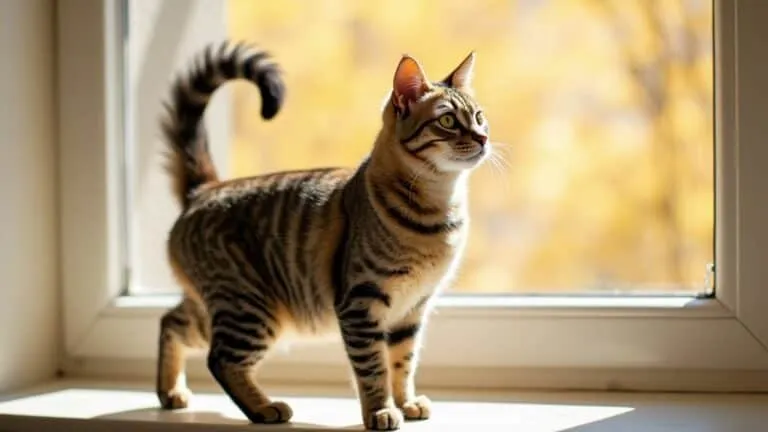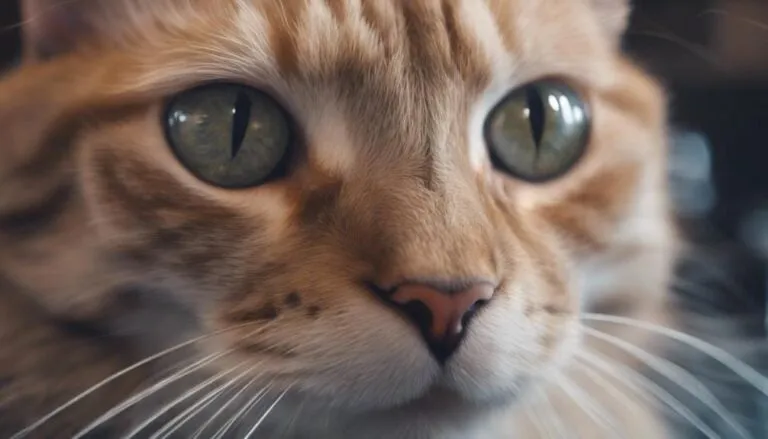The Best Fluffy Pancakes recipe you will fall in love with. Full of tips and tricks to help you make the best pancakes.

Have you ever wondered why your cat seems to have an entire vocabulary of meows? Well, you're not alone. In fact, did you know that cats can produce up to 21 different vocalizations to communicate with us humans? It's truly fascinating how they have adapted their meows to convey specific messages.
But what do these meows really mean? And how can we decipher the hidden messages behind them?
In this article, we will explore the intriguing world of feline communication and unravel the enigma of mysterious meows. Get ready to uncover the secret language of cats and gain a deeper understanding of your furry friend.
Key Takeaways
- Cats primarily use body language and scent to communicate with each other, but they have adapted their meows to communicate with humans.
- Feline vocal repertoire consists of up to 21 different vocalizations, and the meaning behind meows is determined by various factors such as environment, needs, body language, and relationship with humans.
- Cats may meow to meet their basic needs, such as hunger, thirst, and the need for a clean litter box. Providing these necessities can help reduce excessive meowing.
- Cats may meow to seek attention from their owners, especially for cuddling or playtime. Engaging with cats and giving them attention can minimize excessive meowing.
Understanding Feline Communication
Understanding feline communication is crucial for cat owners to effectively interpret their pets' needs and desires. Feline vocalizations and interpreting body language are key aspects of understanding our furry friends.
Cats have a wide range of vocalizations, with up to 21 different types of meows. However, the meaning behind these meows isn't solely dependent on the sound itself. It's influenced by the environment, the cat's needs, body language, and the relationship with their humans.
Additionally, cats primarily use body language and scent to communicate with each other, which can also provide valuable insights into their emotions and intentions.
Meeting Basic Needs Through Meowing
As we delve further into the world of cat communication, it becomes evident that understanding their basic needs through meowing is crucial for providing optimal care and ensuring their well-being.
Cats have mastered the art of meowing as a form of manipulation. When they're hungry, thirsty, or in need of a clean litter box, they'll use their meows to get your attention and prompt you to fulfill their needs.
Moreover, meowing can also be a way for cats to assert dominance. By vocalizing their desires, they aim to establish their position and control over their environment.
As caretakers, it's important to recognize these meows and respond accordingly, ensuring that their basic needs are met and their well-being is prioritized.
Seeking Attention Through Meows
Cats, being social creatures, use their meows as a way to seek attention from their favorite humans. When they want to interact with you, they'll often call for your attention by meowing. It's their way of saying, 'Hey, I want to play!'
Cats understand that their meows can elicit a response from their humans, and they use this knowledge to their advantage. They know that by meowing, they can get you to engage with them in playtime. Whether it's chasing a toy or having a gentle wrestle, cats love the interaction and stimulation that play provides.
Addressing Health and Behavioral Issues
When addressing health and behavioral issues in cats, it's important to consider the underlying causes of their meowing. Cats may meow due to separation anxiety or loneliness, which can be distressing for both the cat and their owner. Managing behavioral issues requires a thoughtful approach and understanding of the cat's needs. Here are some key points to consider:
- Separation Anxiety:
- Cats may meow excessively when left alone for long periods.
- They may exhibit destructive behavior or eliminate outside the litter box.
- Providing comfort items, like a cozy bed or clothing with your scent, can help alleviate their anxiety.
- Managing Behavioral Issues:
- Training and enrichment activities can redirect a cat's attention and prevent excessive meowing.
- Consistency and positive reinforcement are essential in modifying their behavior.
Loneliness and Environmental Influences
Loneliness and environmental influences play a significant role in a cat's meowing behavior. Cats are social creatures and rely on companionship for emotional well-being. When they feel lonely or isolated, they may cry for companionship.
Environmental factors also contribute to their meowing. Cats may cry in another room as a response to their surroundings. For instance, they may be seeking attention or signaling their desire to go outside.
Additionally, our absence can lead to feelings of loneliness in cats, causing them to meow in an attempt to connect with us. It's important to understand and address these environmental influences to ensure our feline friends feel loved and supported.
Providing companionship, engaging in playtime, and creating a stimulating environment can help reduce their meowing and promote their overall happiness.
Different Meowing Patterns in Specific Breeds
Certain cat breeds exhibit distinct meowing patterns that set them apart from other feline companions. Understanding these unique vocalizations can help you better communicate with your furry friend.
Here are some observations regarding specific breeds:
- Siamese Meowing Characteristics:
- Siamese cats are known for their distinctive and loud meows.
- Their meows are often described as high-pitched, demanding, and attention-seeking.
- Siamese cats use their vocalizations to express their needs, whether it's hunger, boredom, or simply wanting your undivided attention.
- Maine Coon Vocalizations:
- Maine Coon cats are also quite vocal but in a different way.
- Their meows are generally softer and more melodic compared to Siamese cats.
- Maine Coons use their meows to communicate affection, greet their owners, and express their playful nature.
Understanding these breed-specific meowing patterns can help you decipher your cat's messages more effectively, ensuring a stronger bond between you and your feline companion.
Nighttime Meows and Their Meanings
As we explore the fascinating world of cat communication, let's now turn our attention to the intriguing realm of nighttime meows and the hidden meanings behind them.
Cats are known to be more active during the night, and their meowing during this time can have various causes. One common cause of nighttime meowing is a desire for attention. Cats may use their meows to call their favorite human for companionship or playtime.
Another possible reason for nighttime meowing is a need for food or water. Hunger or thirst can prompt cats to vocalize their needs in the hopes of receiving nourishment.
Additionally, some cats may meow during the night due to feelings of loneliness or separation anxiety. Interpreting meows during the night requires understanding the cat's unique needs, body language, and relationship with humans.
Strategies to Reduce Excessive Meowing
To address excessive meowing in cats, implementing effective strategies can help reduce this behavior and create a more harmonious environment for both you and your feline companion. Here are some strategies that can help:
- Training techniques:
- Use positive reinforcement to reward desired behaviors and discourage excessive meowing.
- Teach your cat alternative ways to communicate, such as using a bell or a designated scratching post.
- Environmental enrichment:
- Provide interactive toys and puzzles to keep your cat mentally stimulated and engaged.
- Create vertical spaces and hiding spots to allow your cat to explore and feel secure.
Conclusion
In conclusion, by understanding the hidden messages behind your cat's meows, you can strengthen your bond and enhance your communication with them. Whether it's addressing their basic needs, seeking attention, or identifying potential health or behavioral issues, decoding their meows is essential.
Remember, cats have a unique vocal repertoire, and their meowing patterns vary based on their environment and breed. By paying attention to their meows and responding appropriately, you can ensure a happy and fulfilling relationship with your feline companion.








